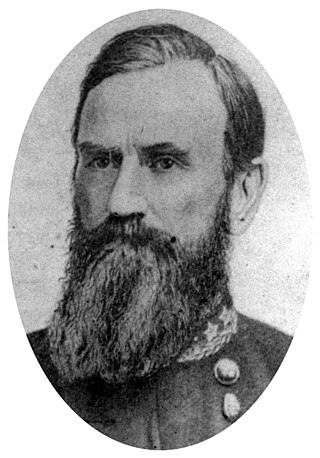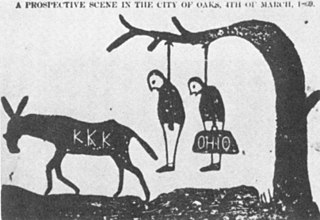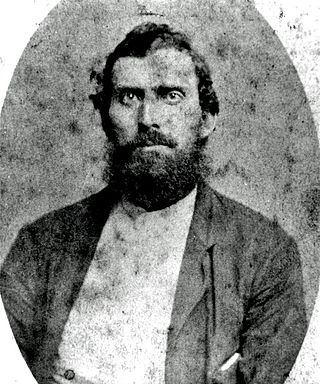Related Research Articles

The American Civil War was a civil war in the United States between the Union and the Confederacy, which had been formed by states that had seceded from the Union.

The Confederate States of America (CSA), commonly referred to as the Confederate States (C.S.), the Confederacy, or the South, was an unrecognized breakaway republic in the Southern United States that existed from February 8, 1861, to May 9, 1865. The Confederacy comprised eleven U.S. states that declared secession and warred against the United States during the American Civil War. The states are South Carolina, Mississippi, Florida, Alabama, Georgia, Louisiana, Texas, Virginia, Arkansas, Tennessee, and North Carolina.

Jones County is in the southeastern portion of the U.S. state of Mississippi. As of the 2020 census, the population was 67,246. Its county seats are Laurel and Ellisville.

Benjamin Grubb Humphreys was an American politician from Mississippi. He was a general in the Confederate States Army during the American Civil War and served as Governor of Mississippi from 1865 to 1868, during Reconstruction.

In United States history, the pejorative scalawag referred to white Southerners who supported Reconstruction policies and efforts after the conclusion of the American Civil War.

The Richmond and Danville Railroad (R&D) Company was a railroad that operated independently from 1847 until 1894, first in the U.S. state of Virginia, and later on 3,300 miles (5,300 km) of track in nine states.

The Lost Cause of the Confederacy is an American pseudohistorical and historical negationist myth that claims the cause of the Confederate States during the American Civil War was just, heroic, and not centered on slavery. First enunciated in 1866, it has continued to influence racism, gender roles, and religious attitudes in the Southern United States into the 21st century. Historians have dismantled many parts of the Lost Cause mythos.

The history of North Carolina from pre-colonial history to the present, covers the experiences of the people who have lived within the territory that now comprises the U.S. state of North Carolina.

Mississippi was the second southern state to declare its secession from the United States, doing so on January 9, 1861. It joined with six other southern states to form the Confederacy on February 4, 1861. Mississippi's location along the lengthy Mississippi River made it strategically important to both the Union and the Confederacy; dozens of battles were fought in the state as armies repeatedly clashed near key towns and transportation nodes.
The bibliography of the American Civil War comprises books that deal in large part with the American Civil War. There are over 60,000 books on the war, with more appearing each month. Authors James Lincoln Collier and Christopher Collier stated in 2012, "No event in American history has been so thoroughly studied, not merely by historians, but by tens of thousands of other Americans who have made the war their hobby. Perhaps a hundred thousand books have been published about the Civil War."

This is a selected bibliography of the main scholarly books and articles of Reconstruction, the period after the American Civil War, 1863–1877.

In the United States, Southern Unionists were white Southerners living in the Confederate States of America opposed to secession. Many fought for the Union during the Civil War. These people are also referred to as Southern Loyalists, Union Loyalists, or Lincoln's Loyalists. Pro-Confederates in the South derided them as "Tories". During Reconstruction, these terms were replaced by "scalawag", which covered all Southern whites who supported the Republican Party.

Newton Knight was an American farmer, soldier and Southern Unionist in Mississippi, best known as the leader of the Knight Company, a band of Confederate Army deserters who resisted the Confederacy during the Civil War. Local legends tell of Knight and his men forming the "Free State of Jones" in the area in and around Jones County, Mississippi, at the height of the war. The nature and extent of the Knight Company's opposition to the Confederate government is disputed among historians. After the war, Knight joined the Republican Party and served in Mississippi's Reconstruction government as a deputy U.S. Marshal.
The civil rights movement (1865–1896) aimed to eliminate racial discrimination against African Americans, improve their educational and employment opportunities, and establish their electoral power, just after the abolition of slavery in the United States. The period from 1865 to 1895 saw a tremendous change in the fortunes of the Black community following the elimination of slavery in the South.
Jacquelyn Dowd Hall is an American historian and Julia Cherry Spruill Professor Emerita at the University of North Carolina at Chapel Hill. Her scholarship and teaching forwarded the emergence of U.S. women's history in the 1960s and 1970s, helped to inspire new research on Southern labor history and the long civil rights movement, and encouraged the use of oral history sources in historical research. She is the author of Revolt Against Chivalry: Jessie Daniel Ames and the Women’s Campaign Against Lynching;Like a Family: The Making of a Southern Cotton Mill World and Sisters and Rebels: The Struggle for the Soul of America.
The following list is a bibliography of American Civil War Confederate military unit histories and are generally available through inter-library loan. More details on each book are available at WorldCat. For an overall national view, see Bibliography of the American Civil War. For histories of the Union, see Bibliography of American Civil War Union military unit histories. For a guide to web sources see: Carter, Alice E.; Jensen, Richard. The Civil War on the Web: A Guide to the Very Best Sites—Completely Revised and Updated (2003).
Rachel Knight was the African-American common-law wife to Confederate army deserter Newton Knight (1829-1922). In 1881 she was baptized into the Church of Jesus Christ of Latter-day Saints. She was depicted by Gugu Mbatha-Raw in Gary Ross' 2016 feature film Free State of Jones.
William M. Hancock was a judge and state legislator in Mississippi. His father was Judge Jubal Braxton Hancock.
The 7th Battalion Mississippi Infantry was a unit in the Confederate States Army during the American Civil War, formed of volunteers from southern Mississippi. The Battalion was organized at Quitman, Mississippi, in May 1862.
The 27th Mississippi Infantry Regiment was a regiment of infantry in the Confederate States Army during the American Civil War. The 27th Mississippi fought in many battles of the Western theater in Kentucky, Tennessee, and Georgia.
References
- ↑ "Victoria E. Bynum". University of North Carolina Press . Retrieved 2021-11-09.
- ↑ Bynum, Victoria E. (1987). Unruly women : the relationship between status and behavior among free women of the North Carolina Piedmont, 1840-1865. University of California, San Diego.
- ↑ "Bynum, Victoria". Texas State University. 2021-11-19. Retrieved 2023-09-07.
- ↑ Walsh, David; Laurier, Joanne. "An interview with Victoria Bynum, historian and author of "The Free State of Jones"". World Socialist Web Site. Retrieved 9 November 2021.
- ↑ Blow, Charles (June 27, 2016). "White Savior, Rape and Romance?". New York Times. Retrieved 9 November 2021.
- 1 2 Cieply, Michael (July 29, 2009). "Civil War Fires Up Literary Shootout". New York Times. Retrieved 9 November 2021.
- ↑ "We Respond to the Historians Who Critiqued the 1619 Project". New York Times. January 19, 2021. Retrieved 9 November 2021.